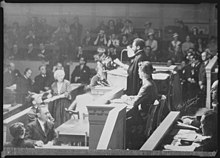Ethiopian Empire in exile

The Ethiopian Empire in exile was a government-in-exile formed when Emperor Haile Selassie fled the country after Italy invaded Ethiopia in 1935. Haile Selassie, recognized by Allied world powers as the de jure and legitimate ruler of Ethiopia, went to Jerusalem via Djibouti by boarding a British ship in 1936.
He then went to a villa Fairfield House in Bath, England accompanied by his children, grandchildren, and servants, and spent the remainder of the time until the liberation of Ethiopia during the East African Campaign in 1941, where he returned to the throne after leaving for five years. Haile Selassie also went to Geneva to address the League of Nations about Ethiopian sovereignty and denounced Italy's actions toward his army on 30 June 1936.
Initial journey[edit]
The government of Ethiopia in-exile occurred when Emperor Haile Selassie fled to Bath (145km west of London) in 1935 as Benito Mussolini declared the invasion of the Ethiopian Empire on 9 May 1936.[1][2]
On 1 May 1936, Haile Selassie took a train to Djibouti and then boarded a British ship.[3]
In Jerusalem[edit]

Jerusalem was a sanctuary to the emperor and the royal family in his exile during the Italian invasion of Ethiopia. This was the second visit of the city in the twentieth century, one in the 1924 grand tour of Europe.[4] While at Jerusalem, Haile Selassie spent the majority of his time with Ethiopian monks, praying with them at the Church of the Holy Sepulcher.[5][6]
In England[edit]

Emperor Haile Selassie fled to Bath (145km west of London) where he was granted asylum by British authorities. However, they did not want to stay in London as long as possible due to being perceived as "politically embarrassing". Upon arrival, he stayed at a hotel. Shortly afterward, he bought Fairfield House to spend the remainder of his time. He was accompanied by his children, grandchildren, servants and others. In Bath, Haile Selassie accustomed to the "army of servants" and living in single house as financially restricted. He was seen getting rid of jewelry on a couple of occasions. Upon leaving England, he left the house for the elderly. In 1954, Haile Selassie visited Bath again.[3]

An estimated 90,000 people of Ethiopian descent lived in Britain, among them were Abiyot Desta, who visited the residence of the emperor for the first time.[1]
In Geneva[edit]
On 30 June 1936, Haile Selassie traveled once to Geneva to plead with the League of Nations that Ethiopia not be officially recognized as part of Italian Empire. He also had European allies who traveled to Ethiopia to report the news about Ethiopian army struggling with Italy.[3][7][8]

The report helped the British to enter Ethiopia with the emperor in the later years. As Italy declared war on the United Kingdom in 1940, the British accompanied Haile Selassie to Sudan and helped him organizing his army within seven months,[9] and finally accomplished it by liberating Ethiopia and returned to the throne on 5 May 1941.[3][10][11]
References[edit]
- ^ a b "Members of Ethiopian Diaspora Gather at British Home of Former Emperor". VOA. 14 January 2020. Retrieved 2022-09-14.
- ^ The New International Year Book. Dodd, Mead and Company. 1941.
- ^ a b c d "Exile In Bath". thehaileselassie.com. Retrieved 2022-09-14.
- ^ "Haile Selassie in Jerusalem Sanctuary for the Lion of Judah in the Holy City" (PDF). 14 September 2022.
- ^ "The Lion of Judah and Jerusalem". embassies.gov.il. Retrieved 2022-09-14.
- ^ Bowers, Keith (2016). Imperial Exile: Emperor Haile Selassie in Britain 1936-1940. TSEHAI Publishers & Distributors. ISBN 978-1-59907-168-8.
- ^ "(1936) Emperor Haile Selassie of Ethiopia, "Appeal to the League of Nations" •". 2008-05-20. Retrieved 2022-09-14.
- ^ Pankhurst, Richard (2002). "Emperor Haile Sellassie's Arrival in Britain: An Alternative Autobiographical Draft by Percy Arnold". Northeast African Studies. 9 (2): 1–46. doi:10.1353/nas.2007.0008. ISSN 0740-9133. JSTOR 41931306. S2CID 144707809.
- ^ Pankhurst, Richard (1996). "Emperor Haile Sellassie's Autobiography, and an Unpublished Draft". Northeast African Studies. 3 (3): 69–109. doi:10.1353/nas.1996.0015. ISSN 0740-9133. JSTOR 41931150. S2CID 143268411.
- ^ "Emperor Haile Selassie I Returns Triumphant to Ethiopia". Origins. Retrieved 2022-09-14.
- ^ "Haile Selassie, last emperor of Ethiopia and architect of modern Africa". HistoryExtra. Retrieved 2022-09-14.
